Related Research Articles

A sound film is a motion picture with synchronized sound, or sound technologically coupled to image, as opposed to a silent film. The first known public exhibition of projected sound films took place in Paris in 1900, but decades passed before sound motion pictures became commercially practical. Reliable synchronization was difficult to achieve with the early sound-on-disc systems, and amplification and recording quality were also inadequate. Innovations in sound-on-film led to the first commercial screening of short motion pictures using the technology, which took place in 1923.
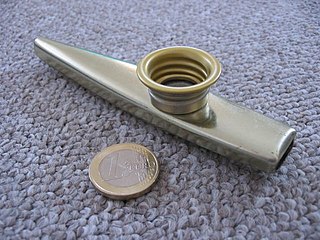
The kazoo is an American musical instrument that adds a "buzzing" timbral quality to a player's voice when the player vocalizes into it. It is a type of mirliton, one of a class of instruments which modifies its player's voice by way of a vibrating membrane of goldbeater's skin or material with similar characteristics.
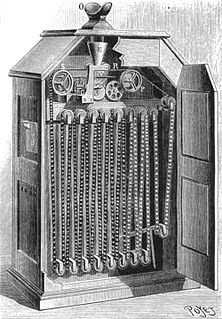
The Kinetoscope is an early motion-picture exhibition device. The Kinetoscope was designed for films to be viewed by one person at a time through a peephole viewer window at the top of the device. The Kinetoscope was not a movie projector, but it introduced the basic approach that would become the standard for all cinematic projection before the advent of video. It created the illusion of movement by conveying a strip of perforated film bearing sequential images over a light source with a high-speed shutter. A process using roll film was first described in a patent application submitted in France and the U.S. by French inventor Louis Le Prince. The concept was also used by U.S. inventor Thomas Edison in 1889, and subsequently developed by his employee William Kennedy Laurie Dickson between 1889 and 1892. Dickson and his team at the Edison lab also devised the Kinetograph, an innovative motion picture camera with rapid intermittent, or stop-and-go, film movement, to photograph movies for in-house experiments and, eventually, commercial Kinetoscope presentations.

Emile Berliner originally Emil Berliner, was a German-American inventor. He is best known for inventing the lateral-cut flat disc record used with a gramophone. He founded the United States Gramophone Company in 1894; The Gramophone Company in London, England, in 1897; Deutsche Grammophon in Hanover, Germany, in 1898; and Berliner Gram-o-phone Company of Canada in Montreal in 1899.

Charles Francis Jenkins was an American engineer who was a pioneer of early cinema and one of the inventors of television, though he used mechanical rather than electronic technologies. His businesses included Charles Jenkins Laboratories and Jenkins Television Corporation. Over 400 patents were issued to Jenkins, many for his inventions related to motion pictures and television.
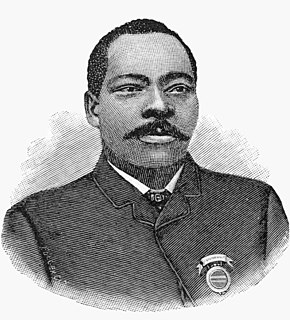
Granville Tailer Woods was an American inventor who held more than 50 patents in the U.S. He was the first African American mechanical and electrical engineer after the Civil War. Self-taught, he concentrated most of his work on trains and streetcars. One of his notable inventions was a device he called the Synchronous Multiplex Railway Telegraph, a variation of induction telegraph which relied on ambient static electricity from existing telegraph lines to send messages between train stations and moving trains. His work assured a safer and better public transportation system for the cities of the United States.
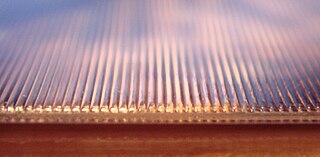
Lenticular printing is a technology in which lenticular lenses are used to produce printed images with an illusion of depth, or the ability to change or move as they are viewed from different angles.

Samuel Hopkins was an American inventor from Philadelphia, Pennsylvania, On July 31, 1790, he was granted the first U.S. patent, under the new U.S. patent statute just signed into law by President Washington on April 10, 1790. Hopkins had petitioned for a patent on an improvement "in the making of Pot ash and Pearl ash by a new Apparatus and Process."

The invention of the telephone was the culmination of work done by many individuals, and led to an array of lawsuits relating to the patent claims of several individuals and numerous companies.

Precursors of film are concepts and devices that have much in common with the later art and techniques of cinema.

Beulah Louise Henry was an American inventor. In the 1930s, she was given the nickname "Lady Edison" for her many inventions. According to the Journal of the Patent Office Society, in 1937, she was known as "America's leading feminine inventor". Famed for being a prolific inventor, Henry patented a wide number of products and innovations designed to improve daily life. Her work was so well known and respected that, as of 1937, she had a museum exhibit dedicated to her in Osaka, Japan, which was seen as an inspiration to aspiring female Japanese inventors.
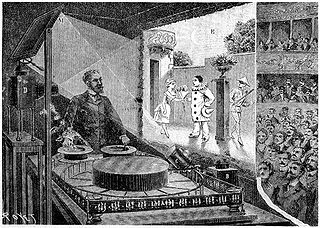
The Théâtre Optique is an animated moving picture system invented by Émile Reynaud and patented in 1888. From 28 October 1892 to March 1900 Reynaud gave over 12,800 shows to a total of over 500,000 visitors at the Musée Grévin in Paris. His Pantomimes Lumineuses series of animated films include Pauvre Pierrot and Autour d'une cabine. Reynaud's Théâtre Optique predated Auguste and Louis Lumière's first commercial, public screening of the cinematograph on 28 December 1895, which has long been seen as the birth of film.
Morton Maimon Mower was an American cardiologist specializing in electrophysiology and the co-inventor of the automatic implantable cardioverter defibrillator. He served in several professional capacities at Sinai Hospital and Cardiac Pacemakers Inc. In 1996, he became the chairman and chief executive officer of Mower Research Associates. He was inducted into the National Inventors Hall of Fame in 2002 for the development of the automatic implantable cardioverter defibrillator with Michel Mirowski in the 1970s. He continued his research in the biomechanical engineering laboratories at Johns Hopkins University.
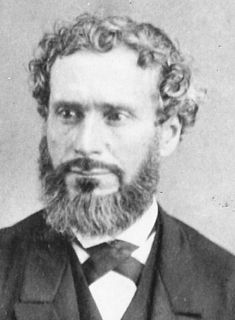
Charles Grafton Page was an American scientist who developed several electrical devices for which he obtained United States patents. He was also a physician, patent examiner, and college professor of chemistry. Like contemporaries Joseph Henry and Michael Faraday, Page began his career as a naturally curious investigator who conducted original research through direct observation and experimentation. Through his experimentation, Page helped develop a scientific understanding of the principles of electromagnetism. Page served as a patent examiner at the United States Patent Office, where his knowledge of electromagnetism was useful in the innovation process and in his own desire to develop electromagnetic locomotion. His work had a lasting impact on telegraphy and in the practice and politics of patenting scientific innovation. Page's views of patenting innovations challenged a commonly held belief at the time that maintained that scientists do not patent their inventions.

A timeline of United States inventions (1890–1945) encompasses the ingenuity and innovative advancements of the United States within a historical context, dating from the Progressive Era to the end of World War II, which have been achieved by inventors who are either native-born or naturalized citizens of the United States. Copyright protection secures a person's right to his or her first-to-invent claim of the original invention in question, highlighted in Article I, Section 8, Clause 8 of the United States Constitution which gives the following enumerated power to the United States Congress:
To promote the Progress of Science and useful Arts, by securing for limited Times to Authors and Inventors the exclusive Right to their respective Writings and Discoveries.

The history of film technology traces the development of techniques for the recording, construction and presentation of motion pictures. When the film medium came about in the 19th century, there already was a centuries old tradition of screening moving images through shadow play and the magic lantern that were very popular with audiences in many parts of the world. Especially the magic lantern influenced much of the projection technology, exhibition practices and cultural implementation of film. Between 1825 and 1840, the relevant technologies of stroboscopic animation, photography and stereoscopy were introduced. For much of the rest of the century, many engineers and inventors tried to combine all these new technologies and the much older technique of projection to create a complete illusion or a complete documentation of reality. Colour photography was usually included in these ambitions and the introduction of the phonograph in 1877 seemed to promise the addition of synchronized sound recordings. Between 1887 and 1894, the first successful short cinematographic presentations were established. The biggest popular breakthrough of the technology came in 1895 with the first projected movies that lasted longer than 10 seconds. During the first years after this breakthrough, most motion pictures lasted about 50 seconds, lacked synchronized sound and natural colour, and were mainly exhibited as novelty attractions. In the first decades of the 20th century, movies grew much longer and the medium quickly developed into one of the most important tools of communication and entertainment. The breakthrough of synchronized sound occurred at the end of the 1920s and that of full color motion picture film in the 1930s. By the start of the 21st century, physical film stock was being replaced with digital film technologies at both ends of the production chain by digital image sensors and projectors.

Barrier-grid animation or picket-fence animation is an animation effect created by moving a striped transparent overlay across an interlaced image. The barrier-grid technique originated in the late 1890s, overlapping with the development of parallax stereography (Relièphographie) for 3D autostereograms. The technique has also been used for color-changing pictures, but to a much lesser extent.
Brewster Color was an early subtractive color-model film process.
William Edward Baekey was an American film and television actor.
References
- ↑ Obituary of Elmer Greensfelder, Baltimore Sun, December 20, 1966
- ↑ Donald Kirkley, "Little Theaters Here Cheer By Award Of Drama League", Baltimore Sun, January 31, 1932.
- ↑ Donald Kirkley, "Half Past Heaven Is Presented At Play-Arts Guild", Baltimore Sun, October 29, 1931.
- ↑ Holly, David. "Elmer Greensfelder", in Baltimore in American Literature. Johns Hopkins University, 1933.
- ↑ United States Patent Office, Method and Apparatus For Synchronously Producing Sounds To Accompany Motion Pictures, Elmer Greensfelder, 1254684, 1918. (accessed October 25, 2009)
- ↑ United States Patent Office, Changeable Profile Toys, Elmer Greensfelder, 2755577, 1956. (accessed October 17, 2009)
- ↑ United States Patent Office, Loose Leaf Binder, Elmer Greensfelder, 1525777, 1925. (accessed October 25, 2009)